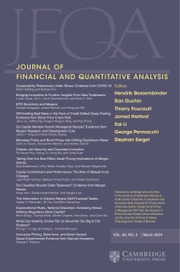No CrossRef data available.
Article contents
Anomalies as New Hedge Fund Factors
Published online by Cambridge University Press: 10 October 2025
Abstract
We identify a parsimonious set of factors from a large pool of candidates for explaining hedge fund returns, ranging from equity market, anomaly, and trend-following factors to macroeconomic factors. The resulting 9-factor model, including five anomaly factors, outperforms existing hedge fund models both in sample and out of sample, with a significant reduction in alphas while showing substantial cross sectional performance heterogeneity. Further analysis based on fund holdings confirms the model’s ability to capture returns from arbitrage trading. Overall, the anomaly factors help quantify hedge fund strategies and risk exposures and improve fund performance evaluation.
Information
- Type
- Research Article
- Information
- Creative Commons
- This is an Open Access article, distributed under the terms of the Creative Commons Attribution licence (http://creativecommons.org/licenses/by/4.0), which permits unrestricted re-use, distribution and reproduction, provided the original article is properly cited.
- Copyright
- © The Author(s), 2025. Published by Cambridge University Press on behalf of the Michael G. Foster School of Business, University of Washington
Footnotes
We are extremely grateful to Hendrik Bessembinder (the editor) and two anonymous referees for their detailed and insightful comments that have substantially improved the article. We thank Vikas Agarwal, Tim Bollerslev, Oleg Bondarenko, Charles Cao, Gregory Eaton, Amit Goyal, Clifton Green, Bing Liang, Alan Moreira, Sugata Ray, Andrea Rossi, Zhen Shi, seminar and conference participants at Aalto University, Texas A&M University, the 16th Annual Hedge Fund Research Conference, and the XJTLU AI and Big Data in Accounting and Finance Research Conference for helpful comments and suggestions. We also thank Vikas Agarwal, Turan Bali, Ken French, Amit Goyal, David Hsieh, Ralph Koijen, Lubos Pastor, and Grigory Vilkov for making a large amount of data available through their websites or direct sharing.

